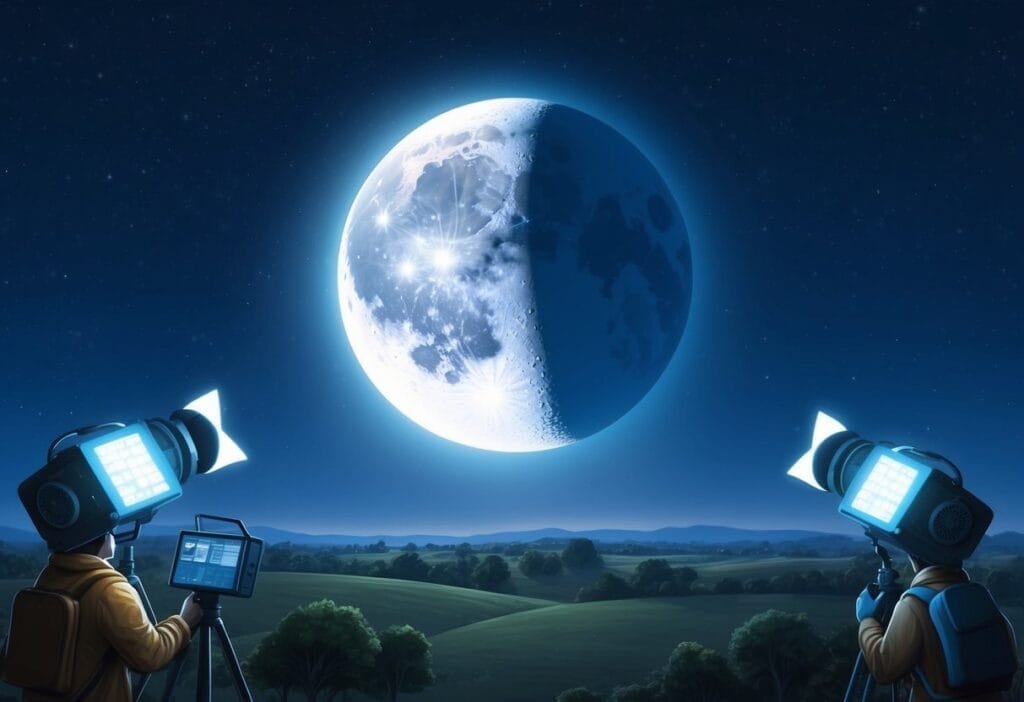Table of Contents
Earth has a new companion in its orbit. Scientists have discovered that our planet has captured Earth’s second moon. This tiny celestial body, known as asteroid 2024 PT5, is now circling Earth in a unique corkscrew-like path.

The mini-moon will stay with us for several weeks before moving on to continue its journey around the sun. Unlike our permanent moon, this temporary visitor is much smaller and farther away. It orbits Earth at a distance of 40 to 100 times that of our familiar moon.
Space fans can try to spot this rare sight in the night sky. While it’s not visible to the naked eye, amateur astronomers with telescopes might catch a glimpse. This event gives scientists a chance to study near-Earth objects up close and learn more about our cosmic neighborhood.
Key Takeaways
- Earth has temporarily captured a small asteroid as a “second moon”
- The mini-moon orbits Earth in a corkscrew path much farther than our main moon
- Scientists can use this event to study near-Earth objects and improve our understanding of space
A New Companion in Earth’s Orbit

Earth has gained a temporary celestial companion. This small asteroid, named 2024 PT5, will briefly orbit our planet as a mini-moon. Its unique characteristics and orbital path make it an intriguing subject for astronomers and space enthusiasts alike.
Characteristics of 2024 PT5
2024 PT5 is a small asteroid measuring about 33 feet long. It belongs to a group called Arjuna asteroids, which have orbits similar to Earth’s. These objects often come close to our planet.
The mini-moon is too small and distant to be seen with the naked eye. Powerful telescopes are needed to observe it. Despite its size, 2024 PT5’s temporary capture by Earth’s gravity is a rare and exciting event for scientists.
Gravitational Capture and Orbital Path
2024 PT5 will be captured by Earth’s gravity from September 29 to November 25, 2024. During this time, it will orbit our planet as a mini-moon. The asteroid’s path will take it about 2.6 million miles away from Earth.
This distance is roughly 10 times farther than our primary moon. The gravitational dance between Earth and 2024 PT5 is delicate. After its brief stay, the asteroid will leave Earth’s orbit and continue its journey around the sun.
Comparison With Earth’s Primary Moon
While 2024 PT5 is called a mini-moon, it differs greatly from Earth’s primary moon:
- Size: 2024 PT5 is much smaller, at just 33 feet long.
- Distance: It orbits much farther away, at 2.6 million miles versus 238,900 miles.
- Orbit duration: The mini-moon stays for weeks, not billions of years.
- Visibility: Unlike the Moon, 2024 PT5 can’t be seen without powerful telescopes.
These differences highlight how unique and fleeting the capture of a mini-moon is compared to our constant lunar companion.
Observing the Mini-Moon

Earth’s new mini-moon, asteroid 2024 PT5, offers a unique viewing opportunity for sky watchers. Its visibility varies based on equipment and timing. Tracking its movements helps predict the best times for observation.
Visibility to the Naked Eye and Through Telescopes
The mini-moon is not visible to the naked eye due to its small size. Professional astronomers use powerful telescopes to observe it. Amateur astronomers with advanced equipment may also spot it.
Most home telescopes lack the power to see 2024 PT5 clearly. The asteroid’s size is similar to a school bus, making it challenging to detect from Earth.
For the best chance of seeing it, observers should use telescopes with:
- Large apertures (8 inches or more)
- High-quality optics
- Dark sky conditions
Tracking Movements and Predicting Visibility
2024 PT5 will orbit Earth from September 29 to November 25. Its path changes nightly, requiring constant tracking for accurate viewing.
Astronomers use specialized software to predict the mini-moon’s location. These predictions help plan observation times and telescope positioning.
Factors affecting visibility include:
- Earth’s rotation
- Moon phases
- Weather conditions
Sky-watching apps and websites often provide up-to-date information on 2024 PT5’s position. This data helps both professional and amateur astronomers plan their viewing sessions.
Scientific Significance and Study

Earth’s “second moon” offers valuable insights into celestial mechanics and near-Earth objects. Scientists study these temporary satellites to better understand our planet’s gravitational interactions and potential asteroid impacts.
Research on Mini-Moon Events
Mini-moon events occur when small asteroids are temporarily captured by Earth’s gravity. Scientists track these objects using powerful telescopes and computer simulations. They analyze the orbits, sizes, and compositions of mini-moons.
Recent discoveries like 2024 PT5 help researchers refine their models. This asteroid will orbit Earth from September to November 2024. Its short stay gives astronomers a chance to study capture and escape mechanics up close.
Mini-moons often follow complex paths around Earth. Some trace horseshoe-shaped orbits, never fully circling our planet. Others spiral in closer before being ejected back into solar orbit.
Insights From Previous Temporary Moons
3753 Cruithne is one of Earth’s best-studied quasi-satellites. It follows a bean-shaped orbit that appears to circle Earth but actually orbits the Sun.
Cruithne’s unusual path has taught astronomers about three-body orbital dynamics. It demonstrates how the Sun and Earth’s gravity can create stable yet complex trajectories.
Other temporary moons have revealed information about asteroid composition. Spectral analysis of these objects helps scientists identify their origins and internal structures.
Impact on Understanding of Near-Earth Objects
Studying mini-moons improves our knowledge of near-Earth asteroids. These objects pose potential impact risks to our planet. By observing temporary captures, scientists can better predict how asteroids behave near Earth.
This research aids in developing asteroid deflection strategies. It also helps refine early warning systems for potential collisions.
Mini-moons from the Arjuna asteroid group are of particular interest. These Earth-like orbit asteroids frequently come close to our planet. Their study informs models of Earth’s long-term gravitational influence on small solar system bodies.
Public Interest and Media Coverage

Earth’s temporary second moon has sparked widespread fascination. People are eagerly discussing this rare celestial event on social platforms and seeking more information from experts.
Social Media Discussions and Speculations
The news of Earth’s second moon has gone viral on social media. Users are sharing photos, asking questions, and making predictions about its impact.
Many are using the hashtag #NewMiniMoon to follow updates. Some speculate about potential effects on tides or weather, though scientists say these are unlikely.
Memes and jokes about the extra moon have also become popular. Funny captions and edited images show the mini-moon in unexpected situations.
Educational Outreach and Public Fascination
Museums and planetariums are offering special programs about the temporary moon. These events help explain the science behind the phenomenon to curious visitors.
Schools are using this as a teaching opportunity. Science classes are covering topics like orbits and gravity using the mini-moon as an example.
Astronomy clubs have seen increased interest. Many are organizing “moon-watching” events for the public to observe both moons together.
Online courses about space and astronomy have gained popularity. People want to learn more about how Earth can capture a second moon.
Potential Implications for the Future
Earth’s temporary second moon opens up new possibilities for space research and asteroid tracking. These mini-moons could play a key role in future space exploration and planetary defense efforts.
Future Mini-Moon Predictions and Their Orbits
Scientists expect more mini-moons to be captured by Earth’s gravity in the coming years. The Asteroid Terrestrial-Impact Last Alert System will help detect these objects. Some mini-moons may complete a full orbit around Earth, while others will have shorter stays.
Researchers are working to predict mini-moon orbits more accurately. This knowledge will help plan future space missions and improve our understanding of near-Earth objects.
Mini-moons often follow complex paths. They can spiral around Earth in corkscrew-like trajectories. These unique orbits make them interesting targets for study.
Risk Assessment of Near-Earth Objects
The discovery of mini-moons highlights the need for better tracking of near-Earth objects. While most are harmless, some could pose risks.
Scientists use advanced technologies to monitor asteroids that come within close range of Earth. They assess the potential impact of these objects on our planet.
Mini-moons provide valuable data for improving risk assessment models. By studying their behavior, experts can better predict the movements of other near-Earth objects.
Space Exploration and Mission Opportunities
Mini-moons offer exciting new targets for space missions. Their close proximity to Earth makes them easier to reach than other celestial bodies.
Future missions could study mini-moons up close. This research could provide insights into the composition of asteroids and the early solar system.
Mini-moons might serve as stepping stones for more ambitious space exploration. They could be used to test new technologies or as refueling stations for deep space missions.
By 2025, space agencies may launch dedicated missions to study these temporary moons. Such missions could pave the way for asteroid mining and other space-based industries.
Frequently Asked Questions
Q: What is Earth’s second moon?
A: Earth’s second moon refers to a temporary quasi-satellite that orbits our planet, such as the asteroid 2020 CD3, which was captured by Earth’s gravity and orbited for about 18 months.
Q: How does a quasi-satellite differ from a traditional moon?
A: Unlike traditional moons, which have stable long-term orbits, quasi-satellites like 2020 CD3 have temporary orbits and may eventually escape Earth’s gravitational pull after a few years.
Q: Can we expect to get a new moon in the future?
A: Yes, new quasi-satellites can be captured by Earth’s gravity, and astronomers are constantly monitoring for new objects that may become temporary moons.
Q: What is the size of these quasi-satellites?
A: Quasi-satellites can vary in size, with some being around 10 meters in diameter, while others may be larger; for instance, 2024 PT5 is expected to be feet wide.
Q: How close do these objects approach Earth?
A: Quasi-satellites can approach Earth at close ranges, with 2024 PT5 expected to come within a range of around 2.8 million miles in its close approach.
Q: Are there any amateur telescopes that can observe these objects?
A: Yes, amateur telescopes equipped with CCD or CMOS technology can be used to observe these quasi-satellites as they approach Earth, especially during close flybys.
Q: What is the significance of the Arjuna asteroid belt in relation to quasi-satellites?
A: The Arjuna asteroid belt contains numerous asteroids that may be potential candidates for becoming quasi-satellites if they enter Earth’s gravitational influence.
Q: How long can a quasi-satellite orbit Earth?
A: Quasi-satellites can orbit Earth for varying periods, typically lasting a few years; for example, 2020 CD3 orbited for about 18 months before escaping Earth’s gravity.
Q: Who discovered the asteroid 2020 CD3?
A: The asteroid 2020 CD3 was identified by astronomers, including Carlos de la Fuente Marcos, who study near-Earth objects and their interactions with our planet.
Q: What will happen to 2024 PT5 after its close approach?
A: After its close approach, 2024 PT5 is expected to stick around for a few years before either being ejected from Earth’s orbit or moving into a different orbital path.

